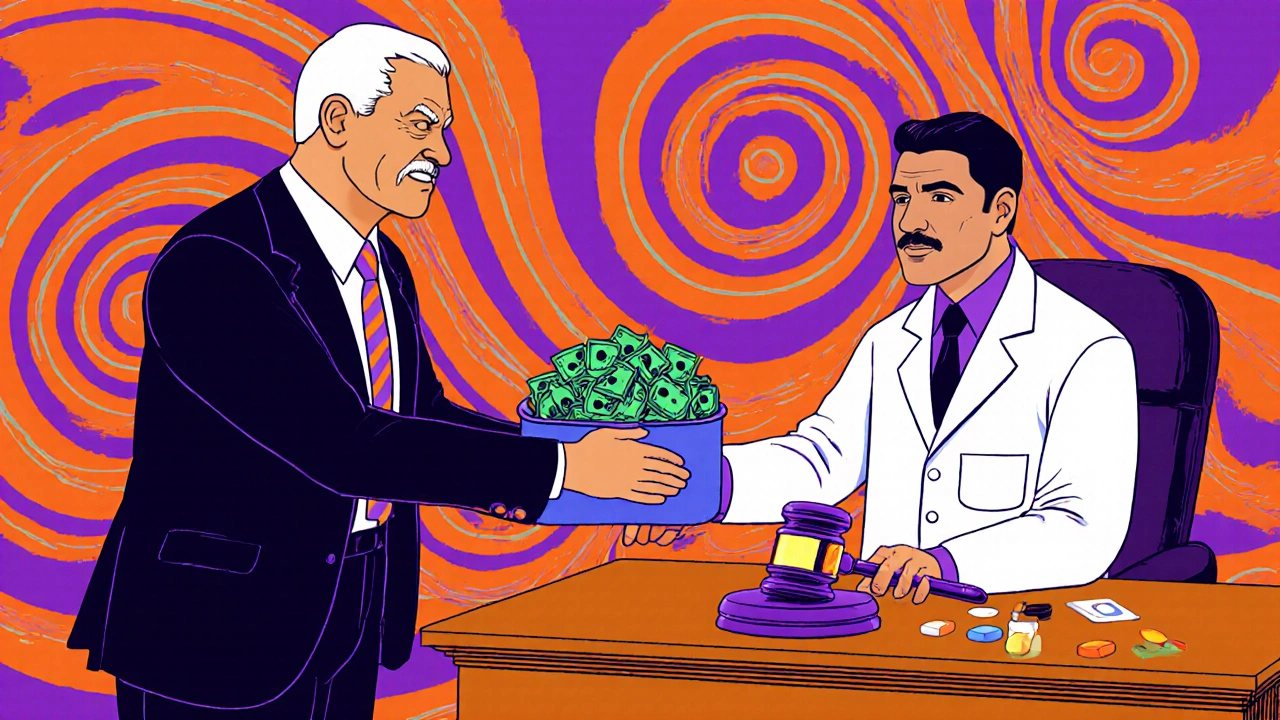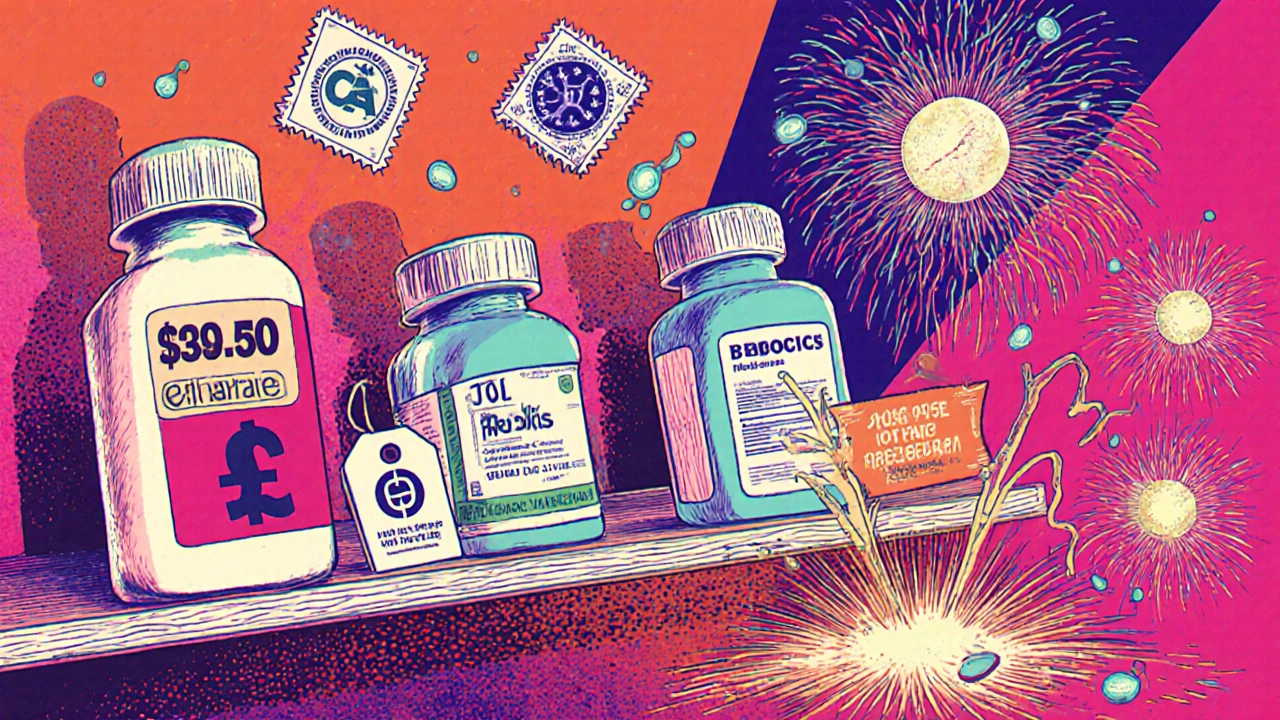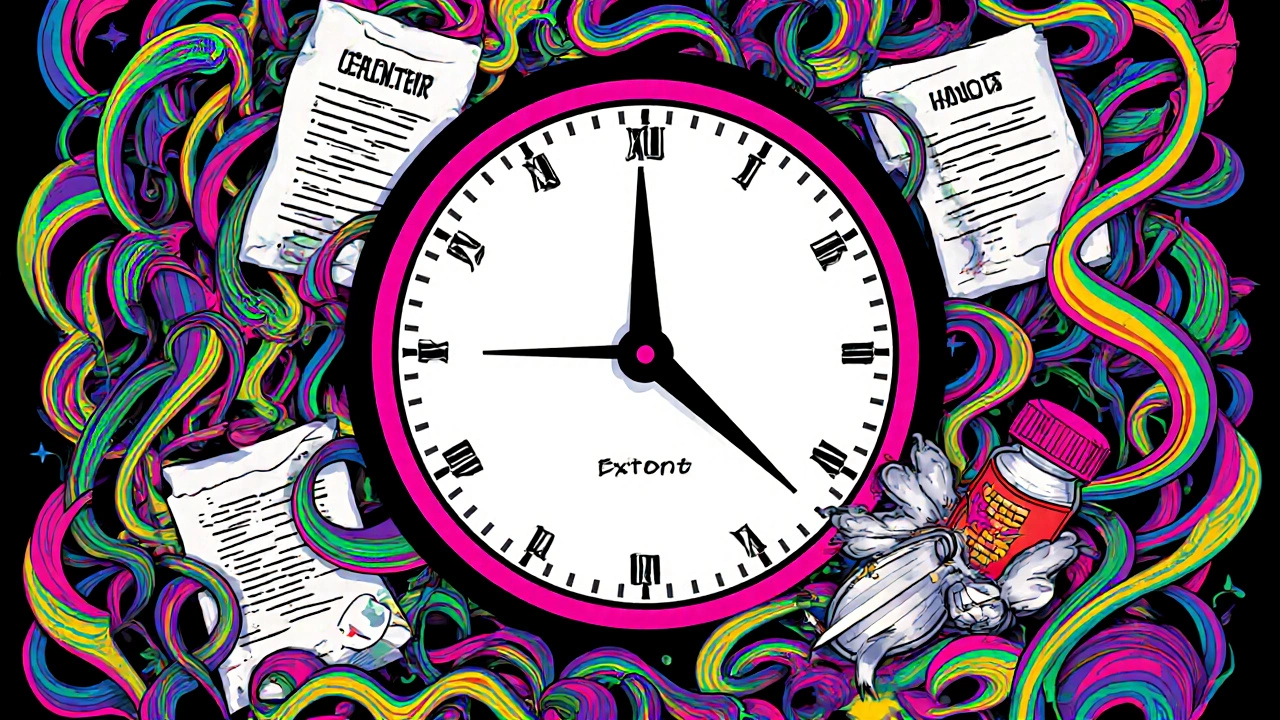When a brand-name drug’s patent runs out, you might think generics hit the shelves right away. But that’s not how it works. In reality, it can take years after patent expiration before a generic version actually shows up in your pharmacy. Even if the FDA approves it, the drug might still be locked behind legal battles, manufacturing delays, or clever patent tricks by the original maker. If you’re trying to save money on prescriptions, understanding this gap is crucial.
Why Don’t Generics Launch Right After the Patent Expires?
The idea behind generic drugs is simple: copy the active ingredient, prove it works the same way, and sell it cheaper. The Hatch-Waxman Act of 1984 set up the system to make this possible through the Abbreviated New Drug Application (ANDA). Generic companies don’t need to run new clinical trials. They just need to show their version is bioequivalent - meaning it delivers the same amount of medicine into your bloodstream at the same rate as the brand-name drug. But here’s the catch: patents aren’t the only barrier. Brand-name drugmakers get extra layers of protection called "exclusivity periods" that have nothing to do with patents. If a drug is a new chemical entity, the FDA gives it five years of market exclusivity. Add a new use or formulation? That’s three more years. If it’s for a rare disease, orphan drug exclusivity kicks in for seven years. And if the company runs extra pediatric studies, they get six more months. These aren’t patents - they’re regulatory blocks. Even if the patent expires, you can’t legally sell a generic until these run out too.The Patent Game: Thickets, Listings, and Delays
Brand-name companies don’t rely on just one patent. They build what experts call a "patent thicket." For a single drug, you might see 10, 15, even 20 patents listed in the FDA’s Orange Book. These cover everything: the active ingredient, how it’s made, how it’s packaged, even how it’s taken. One patent might cover the pill’s coating. Another might cover a specific dosage schedule. Each one has its own 20-year clock, starting from when it was filed - often years before the drug even hits the market. Because of this, the real clock for generic entry doesn’t start when the first patent expires. It starts when the last one does. A 2023 study found that brand-name drugs have, on average, 14.2 patents listed in the Orange Book. That means generic makers have to pick through a minefield. If they challenge even one patent and lose, they can’t launch. If they challenge too many, they risk lawsuits that drag on for years.The 30-Month Stay: A Legal Pause Button
When a generic company files an ANDA and says, "Our drug doesn’t infringe your patent," the brand-name company has 45 days to sue. If they do, the FDA is legally required to delay approval for up to 30 months. This is called the 30-month stay. It sounds like a big deal - and it is. But here’s what most people don’t realize: the 30-month stay rarely stops generic entry. In fact, studies show that most generics launch after the stay ends - sometimes years later. Why? Because lawsuits take time. The average court case lasts over three years. Many generics never even get to court. Instead, the brand-name company and the generic maker settle. And here’s the dark side: some of these settlements are "reverse payments." The brand-name company pays the generic maker to stay off the market. The FTC estimates these deals cost consumers $3.5 billion a year. In 2021, the Supreme Court ruled these kinds of secret deals could violate antitrust laws - but they still happen.
First-to-File: The 180-Day Prize
There’s a big reward for the first generic company to challenge a patent successfully: 180 days of exclusive market access. No other generic can enter during that time. That’s a huge financial incentive. But it’s also a trap. To claim that exclusivity, the first filer must launch within 75 days of FDA approval. That’s not a lot of time. If they’re still fixing manufacturing issues, if their supply chain isn’t ready, or if they get hit with another lawsuit, they lose the exclusivity. About 22% of first filers forfeit the 180-day window because they’re not ready to sell. That means the market opens up to everyone - and prices drop faster than expected. This pressure leads to real-world problems. Some companies rush production and end up with quality issues. The FDA has had to recall generic versions of blood pressure and diabetes drugs because they contained cancer-causing impurities. The race to be first isn’t just about money - it’s about safety.Why Some Generics Take Forever to Arrive
Not all drugs are created equal. Simple pills? Generics usually show up within 1.5 years of patent expiration. But complex drugs? That’s a whole different story. Biologics - drugs made from living cells, like insulin or rheumatoid arthritis treatments - face a whole different approval path under the BPCIA. Even after the patent expires, it can take nearly five years for a biosimilar to get approved. Why? Because these drugs are harder to copy. They’re not just chemicals - they’re living molecules. Small changes in manufacturing can change how they work. The FDA has to be extra careful. Then there are drugs with patent thickets. Cardiovascular drugs, for example, average 3.4 years of delay after patent expiration. Dermatology drugs? Just 1.2 years. The difference? It’s all about how many patents the brand-name company filed and how aggressively they defend them.Who Controls the Generic Market?
The generic drug market isn’t crowded with small players. It’s dominated by three giants: Teva, Viatris, and Sandoz. Together, they control nearly half of the $70 billion U.S. generic market. That means they have the resources to fight long patent battles and invest in complex manufacturing. Smaller companies often can’t afford to challenge patents. They wait for the big players to clear the path, then jump in. That’s why you might see one generic version appear, then another a few months later - and then a third, cheaper one after that. The first one is expensive because of the 180-day exclusivity. The third one? It’s often half the price.
What’s Changing? And What’s Not
There’s been progress. The FDA’s GDUFA II program, updated in 2023, promised faster reviews for complex generics - cutting approval time from 36 months to 24. But as of mid-2024, only 62% of applications met that target. The CREATES Act tried to stop brand-name companies from blocking generic makers from getting samples to test their products. The Orange Book Transparency Act forced companies to list patents more accurately - and it cut patent disputes by 32% in its first year. But the biggest problem remains: patent evergreening. Companies make tiny changes to a drug - a new coating, a different pill shape - and file a new patent. The FDA approves it. Suddenly, the generic clock resets. A 2024 study found that 68% of brand-name drugs get at least one new patent within 18 months of their original patent expiring. That’s not innovation. That’s a tactic.What This Means for You
If you’re paying out of pocket for a brand-name drug, don’t assume a generic will appear on day one. Check with your pharmacist. Ask if there’s a generic available - and if not, ask why. Sometimes, the delay is legal. Other times, it’s just corporate strategy. The good news? Generics still save the U.S. healthcare system $373 billion a year. They make up 92% of all prescriptions filled. But if you’re waiting for one and it’s not there, you’re not alone. The system is designed to delay competition - even when the patent is gone.What’s Next?
The FDA is exploring AI to speed up bioequivalence testing. If it works, generic development could shrink by 25%. Biosimilars for biologics are also gaining ground - they’re expected to capture 45% of the market by 2030. But until patent thickets are broken and reverse payments are fully outlawed, the gap between patent expiration and real availability will stay wide. The truth is simple: the law says generics should be available after patents expire. But the system lets companies stretch that timeline - sometimes for years. Knowing how it works doesn’t fix it. But it helps you ask the right questions - and maybe, just maybe, push for change.How long after a patent expires does a generic drug usually become available?
On average, it takes about 18 to 21 months after patent expiration for a generic drug to reach the market. But this varies widely. Some generics appear within months, while others can take over three years - especially if there are multiple patents, legal challenges, or manufacturing delays.
Why are generic drugs cheaper than brand-name drugs?
Generic drugs cost less because manufacturers don’t have to repeat expensive clinical trials. They only need to prove their version is bioequivalent to the brand-name drug. Without the costs of research, marketing, and patent protection, they can sell at a fraction of the price - often 80% to 85% lower.
Can a brand-name drug company stop a generic from launching?
Yes, through legal means. If a generic company files a patent challenge, the brand-name company can sue, triggering a 30-month FDA approval delay. They can also file multiple patents to create a "patent thicket," making it harder and riskier for generics to enter. Some companies even pay generics to delay launch - a practice called "reverse payment," which is now legally risky but still occurs.
What is the 180-day exclusivity period for generics?
The first generic company to successfully challenge a patent gets 180 days of exclusive rights to sell that generic version. No other generic can enter during that time. This incentive encourages patent challenges, but the first filer must launch within 75 days of FDA approval - or lose the exclusivity.
Are all generic drugs safe and effective?
Yes. The FDA requires all generic drugs to meet the same strict standards as brand-name drugs for quality, strength, purity, and performance. They must be bioequivalent - meaning they work the same way in your body. However, manufacturing issues have caused recalls in rare cases, often tied to rushed production or poor quality control - not because generics are inherently less safe.
What’s the difference between a generic and a biosimilar?
Generics are exact copies of small-molecule drugs made from chemicals. Biosimilars are highly similar versions of complex biologic drugs made from living cells. Because biologics are harder to replicate, biosimilars aren’t exact copies - but they must be proven to have no meaningful clinical differences. Approval for biosimilars takes longer and is more complex than for traditional generics.

Sammy Williams
November 20, 2025 AT 22:27Man, I just got burned paying $400 for my diabetes med last month. Found out the generic’s been approved for 18 months and they’re still acting like it’s the first day of launch. Corporate greed is wild.
Chris Vere
November 22, 2025 AT 11:49It's not just about patents. The entire system is engineered to delay competition. The FDA, the courts, the manufacturers-they're all part of the same machine. We're not talking about innovation here. We're talking about profit maximization disguised as regulation.
Willie Doherty
November 23, 2025 AT 23:11Let’s be precise: the 30-month stay is a legal fiction. The real bottleneck is the 180-day exclusivity incentive structure, which creates perverse outcomes. First-filer delays, manufacturing bottlenecks, and reverse payments are symptoms-not causes. The root is the orphan drug and pediatric exclusivity extensions, which are statistically the largest contributors to market delay. Source: FDA Orange Book data 2020–2024.
Elaina Cronin
November 24, 2025 AT 02:10I find it morally repugnant that a company can pay another company not to sell a life-saving drug. This isn't capitalism. This is extortion with a law degree. The fact that the Supreme Court called it 'potentially unlawful' and yet it still happens? That’s not a flaw in the system. That’s the system.
Pravin Manani
November 24, 2025 AT 04:48From a pharmacoeconomic standpoint, the bioequivalence threshold (80–125% AUC) is the critical variable. Most recalls stem from Cmax deviations, not therapeutic equivalence. The real issue is the lack of post-marketing surveillance for generics-especially when they’re manufactured offshore. We assume bioequivalence = safety, but pharmacokinetics don’t capture all patient variability. We need real-world evidence protocols.
Franck Emma
November 24, 2025 AT 05:54They’re literally robbing us. I can’t breathe.
David Cusack
November 24, 2025 AT 15:05One must ask: is the Hatch-Waxman Act not merely a Faustian bargain? A quid pro quo wherein the public surrenders access to affordable medicines in exchange for the illusion of innovation. The patent thicket-oh, how delightfully Orwellian! One cannot help but wonder whether the Orange Book is a ledger or a labyrinth.
Leo Tamisch
November 25, 2025 AT 20:41So basically Big Pharma is just playing chess with our health 😒💸
And we’re the pawns. I mean… wow. Just wow. 🤡
Steve Harris
November 27, 2025 AT 10:55I’ve worked in pharmacy for 18 years, and I’ve seen this play out over and over. The first generic comes in at $120 a month. Then, after the 180-day window, another hits at $60. Then, six months later, a third from a different manufacturer drops to $18. The system isn’t broken-it’s designed this way. The only way to win is to wait. Or switch to mail-order and buy in bulk. And yes, I’ve had patients cry because they couldn’t afford the brand even after the patent expired. It’s not a market failure. It’s a moral failure.
Donald Frantz
November 28, 2025 AT 12:18People act like this is new. It’s not. The same tactics were used with insulin in the 90s. The same with statins. The same with antiretrovirals. The pattern is predictable: patent + exclusivity + litigation + settlement = delayed access. The only difference now is we have data to prove it. The question isn’t whether it’s happening-it’s why we still tolerate it.
Sandi Moon
November 29, 2025 AT 12:51Did you know the FDA’s own internal audit revealed that 73% of the patents listed in the Orange Book are irrelevant? That’s not a mistake. That’s a coordinated campaign. The government is complicit. The pharmaceutical lobby spends $300 million a year on lobbying. The FDA commissioner’s next job? A board seat at Pfizer. This isn’t capitalism. It’s a cartel with a seal of approval.
Julia Strothers
November 30, 2025 AT 21:14China makes 80% of our generic APIs. Do you really think they care about your insulin? This isn’t about patents-it’s about national security. We’re letting foreign powers control our medicine supply. This is a bio-warfare vulnerability. And nobody’s talking about it.
Ricardo Fiorelli
December 2, 2025 AT 06:49Just checked my prescription-generic’s finally here. $12 for a 30-day supply. Took 2.5 years. Worth the wait.